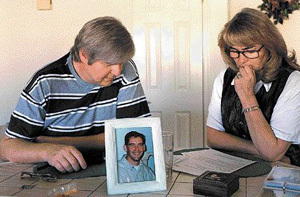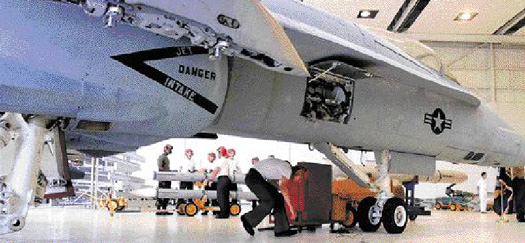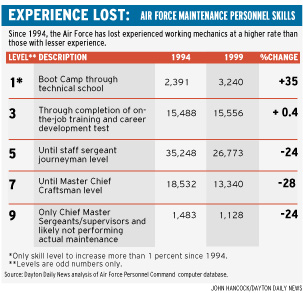| SHOPS SHORTHANDED, WORKLOAD GREAT The military had a plan to deal with the influx of inexperienced personnel: Watch them closely. "You always have a lot of young people. Of course you got to let them work on aircraft," said Delk, the retired maintenance officer. "It boils down to supervision. You can't let them work unsupervised." But in several cases examined by the Dayton Daily News, shops were so shorthanded and the workload so great that critical repairs were made by the only mechanics available, qualified or not. A Navy investigation into a Feb. 12, 1990, accident involving an AH-1W Super Cobra helicopter in California found: "Only 25 percent of the squadron maintenance personnel were school-trained and qualified on the AH-1W. These personnel were mainly in supervisory positions." The Marine Corps F-18 Hornet that Capt. Mark R. Nickles of Mesa, Ariz., and Maj. Danny A. D'Eredita crashed off the coast of South Korea on Feb. 9, 1997, was maintained by what a commander called a "very junior" squadron that suffered from an "experience void, especially in the supervisory role." Young corporals, the commander wrote, were allowed to inspect the work of other mechanics. Compounding the experience problems were other problems typical to military maintenance units: 12-hour shifts, operating in a temporarily overseas deployment, lack of spare parts, newly assigned mechanics unfamiliar with their co-workers and what the military describes as a "high operational tempo," a demanding and intense training operation.  DAVID SMITH/FOR THE DAYTON DAILY NEWS'FOR ME, IT'S NEVER going to get better. You just have to learn to live with the pain,' said Barbara Kaliszek (shown with husband Andrew Kaliszek). Her son, Capt. Mark R. Nickles of Mesa, Ariz., died when his F-18 crashed off the coast of South Korea. DAVID SMITH/FOR THE DAYTON DAILY NEWS'FOR ME, IT'S NEVER going to get better. You just have to learn to live with the pain,' said Barbara Kaliszek (shown with husband Andrew Kaliszek). Her son, Capt. Mark R. Nickles of Mesa, Ariz., died when his F-18 crashed off the coast of South Korea.
|
Both pilots died. When Nickles, 29, and D'Eredita, 38, took off that day, the squadron's mechanics were in violation of a directive to service the plane's oxygen system. The directive, which followed complaints from other F-18 pilots, reduced the interval for servicing the oxygen system to every 400 hours. The F-18 carrying Nickles and D'Eredita was overdue for servicing by 149 hours. "Mark and I were real close," his mother, Barbara Kaliszek, said during an interview at her Phoenix, Ariz., home, where a large photograph of her smiling son on his honeymoon still hangs on the refrigerator. "For me, it's never going to get better. You just have to learn to live with the pain. "The only reason I went to work was because I was afraid to stay in the house by myself -- (afraid) of taking my own life." Navy investigators acknowledged that the oxygen system could have failed. But Rear Admiral Frank M. "Skip" Dirren, Jr., commander of the safety center in Norfolk, Va., insisted that the plane was flying too low to make the oxygen system critical to the pilots. "We think we did a good investigation," Dirren said. "We think we found the answer." The Navy determined that both pilots passed out at the same time from the effects of "G" forces, pressure on the body produced by the acceleration of the aircraft. The Navy made its determinations without recovering the wreckage or the bodies. "We're convinced it was G lock, and we made a decision not to recover (the wreckage)," Dirren said. An investigator wrote that even if the bodies and wreckage were recovered, "it is doubtful that it would produce new evidence to dispute the first listed opinion." Nickles' stepfather, Andrew Kaliszek, who holds a Ph.D. in mechanical engineering and is a scientist who conducts research on aircraft guidance systems, strongly suspects problems with the oxygen system could have enhanced the effects of the "G" forces on the pilots. Lack of oxygen, he said, can make a pilot more susceptible to the effects of "G" forces. "That's what I believe happened," he said. Nineteen days after Nickles and D'Eredita were killed, another F-18 from their squadron reported a "complete on-board oxygen generating system failure in flight." SYSTEM PRONE TO FAILURE Having the most highly trained and experienced mechanics working under close supervision doesn't guarantee safety. Sometimes the system itself is broken. On July 20, 1990, Allison Engine Co., which makes engines for the Army's OH-58 Kiowa Warrior helicopter, warned its civilian and military customers to replace a fuel line with a new thicker tube, one that would not break so easily. Allison issued a bulletin that required replacement of the old tube by no later than June 30, 1991, or within the next 50 hours of operation, whichever came first, and warned that failure of the old tubes could cause "power loss." The old tube, Allison warned, "is susceptible to a higher failure rate than other similar tubes." Nearly seven years later, on June 19, 1997, an Idaho National Guard OH 58 helicopter on a flight to help flood victims, lost power and fell from the sky, striking a fence post and rupturing a fuel tank just before it crashed and burst into flames. "The fire was so bad at first you couldn't see anything but fire," a witness told accident investigators, adding that one of the crew members screamed, " 'Help me. Help me. . . . Get me away from the fire.' " Maj. Don Baxter, 41, who had just taken command of the state's flood relief effort, and Lt. Will Neal, 29, married and the father of a young daughter, were killed. Unsatisfied that the Army's public report did not pinpoint a cause, the Idaho National Guard sent the engine to a civilian company, R.J. Waldron & Co., Ltd. of British Columbia. The Waldron report, released by the Army, blamed the crash on the same faulty fuel tube Allison had warned about seven years earlier. "No formal information was available as to whether or not the Army was using the new part. . .or if they had been informed of the change," the Waldron report says. The Army refused to comment on the accident. Sometimes solutions get lost in the military's huge bureaucracy. On Jan. 30, 1990, a CH-53E Super Stallion helicopter from Marine Medium Helicopter Squadron 164 at North Island, Calif., reported a potentially deadly problem with the tail rotor. Almost immediately investigators requested a Hazardous Material Report, setting in motion a warning intended to prevent an accident. Nearly two weeks later, on Feb. 12, a CH-53E from Marine Heavy Helicopter Squadron 461, also in California, was headed for a landing zone with eight passengers and four crew members when Capt. Michael P. Nagelin heard a noise and felt the helicopter shutter. The tail rotor stopped spinning and the helicopter crashed, injuring one soldier standing near the landing site and inflicting what the Navy estimated at more than $900,000 damage. Navy investigators determined that a tail rotor coupling, the same part that triggered the Hazardous Material Report two weeks earlier, had failed. On March 7, 1990 -- more than three weeks after the crash -- Squadron 461 received the Hazardous Material Report from Squadron 164 concerning potential problems with the tail rotor coupling on CH-53E helicopters. "We were happy to have survived," Nagelin said in an interview. In this case, he said, the military made a determination before his accident that the problem wasn't serious enough to warrant more action, and he didn't completely disagree with that decision. In other cases, Nagelin said, the military has waited too long to fix problems. "They wait till somebody dies, and then they do something about it," said Nagelin, who once served as a Marine Corps aviation safety officer. "That was the general feeling in the fleet, especially when money was tight. "They fly it and watch it. . . . They're not fixing it. All they're doing is telling us to work with it. Rather than make the fix, to save money, you live with the hazard."  SKIP PETERSON/DAYTON DAILY NEWSSAILORS TAKE TRAINING classes at the Naval Air Technical Training Center in Pensacola, Fla. Navy and Air Force recruits still in initial training are being used to maintain aircraft primed for live missions. SKIP PETERSON/DAYTON DAILY NEWSSAILORS TAKE TRAINING classes at the Naval Air Technical Training Center in Pensacola, Fla. Navy and Air Force recruits still in initial training are being used to maintain aircraft primed for live missions.
|
Text-only version Copyright, Dayton Daily News.
|  During the past 20 years, the services cut by up to one-half the length of training required for aviation mechanics.
During the past 20 years, the services cut by up to one-half the length of training required for aviation mechanics. 
 DAVID SMITH/FOR THE DAYTON DAILY NEWS'FOR ME, IT'S NEVER going to get better. You just have to learn to live with the pain,' said Barbara Kaliszek (shown with husband Andrew Kaliszek). Her son, Capt. Mark R. Nickles of Mesa, Ariz., died when his F-18 crashed off the coast of South Korea.
DAVID SMITH/FOR THE DAYTON DAILY NEWS'FOR ME, IT'S NEVER going to get better. You just have to learn to live with the pain,' said Barbara Kaliszek (shown with husband Andrew Kaliszek). Her son, Capt. Mark R. Nickles of Mesa, Ariz., died when his F-18 crashed off the coast of South Korea.



 SKIP PETERSON/DAYTON DAILY NEWSSAILORS TAKE TRAINING classes at the Naval Air Technical Training Center in Pensacola, Fla. Navy and Air Force recruits still in initial training are being used to maintain aircraft primed for live missions.
SKIP PETERSON/DAYTON DAILY NEWSSAILORS TAKE TRAINING classes at the Naval Air Technical Training Center in Pensacola, Fla. Navy and Air Force recruits still in initial training are being used to maintain aircraft primed for live missions.